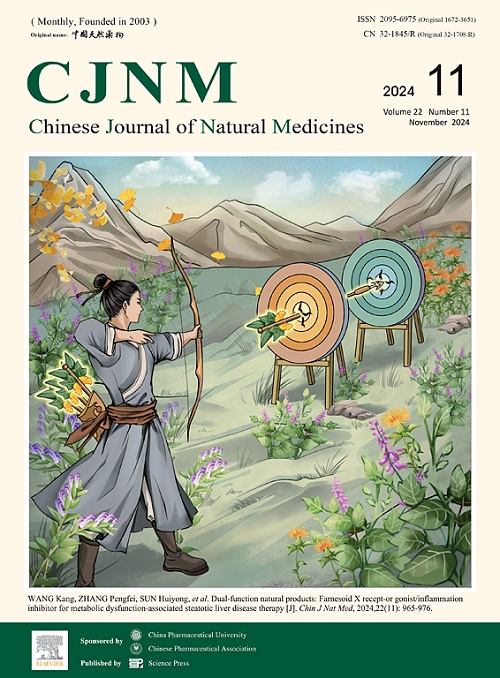Profiling the chemical differences of diterpenoid alkaloids in different processed products of Aconiti Lateralis Radix Praeparata by UHPLC-LTQ-Orbitrap mass spectrometry combined with untargeted metabolomics and mass spectrometry imaging
IF 4.9
2区 医学
Q1 INTEGRATIVE & COMPLEMENTARY MEDICINE
引用次数: 0
Abstract
Aconiti Lateralis Radix Praeparata (Fuzi) represents a significant traditional Chinese medicine (TCM) that exhibits both notable pharmacological effects and toxicity. Various processing methods are implemented to reduce the toxicity of raw Fuzi by modifying its toxic and effective components, primarily diterpenoid alkaloids. To comprehensively analyze the chemical variations between different Fuzi products, ultra-high performance liquid chromatography-linear ion trap quadrupole Orbitrap mass spectrometry (UHPLC-LTQ-Orbitrap MS) was employed to systematically characterize Shengfuzi, Heishunpian and Baifupian. A total of 249 diterpenoid alkaloids present in Shengfuzi were identified, while only 111 and 61 in Heishunpian and Baifupian were detected respectively, indicating substantial differences among these products. An untargeted metabolomics approach combined with multivariate statistical analysis revealed 42 potential chemical markers. Through subsequent validation using 52 batches of commercial Heishunpian and Baifupian samples, 8 robust markers distinguishing these products were identified, including AC1-propanoic acid-3OH, HE-glucoside, HE-hydroxyvaleric acid-2OH, dihydrosphingosine, N-dodecoxycarbonylvaline and three unknown compounds. Additionally, the MS imaging (MSI) technique was utilized to visualize the spatial distribution of chemical constituents in raw Fuzi, revealing how different processing procedures affect the chemical variations between Heishunpian and Baifupian. The distribution patterns of different diterpenoid alkaloid subtypes partially explained the chemical differences among products. This research provides valuable insights into the material basis for future investigations of different Fuzi products.
UHPLC-LTQ-Orbitrap质谱联用非靶向代谢组学和质谱成像分析附子不同炮制品中二萜类生物碱的化学差异
附子是一种重要的中药,具有显著的药理作用和毒性。通过对附子的有毒有效成分(主要是二萜类生物碱)进行改性,采用多种加工方法降低附子的毒性。为了全面分析不同附子产品之间的化学差异,采用超高效液相色谱-线性离子阱四极杆轨道阱质谱法(UHPLC-LTQ-Orbitrap MS)对生附子、黑顺片和白附片进行了系统表征。生附子中共检出249种二萜类生物碱,黑顺片和白附片中分别检出111种和61种,差异较大。非靶向代谢组学方法结合多元统计分析发现了42种潜在的化学标记。通过对52批黑顺片和白附片的商品样品进行验证,鉴定出8个区分产品的稳健标记,包括ac1 -丙酸- 3oh、he -葡萄糖苷、he -羟戊酸- 2oh、二氢鞘氨醇、n -十二脱氧羰基缬氨酸和3个未知化合物。此外,利用MS成像(MSI)技术可视化了生附子中化学成分的空间分布,揭示了不同加工工艺对黑顺片和白附片化学成分变化的影响。不同二萜生物碱亚型的分布格局部分解释了不同产品间的化学差异。本研究为今后对扶子产品的研究提供了有价值的物质基础。
本文章由计算机程序翻译,如有差异,请以英文原文为准。
求助全文
约1分钟内获得全文
求助全文
来源期刊

Chinese Journal of Natural Medicines
INTEGRATIVE & COMPLEMENTARY MEDICINE-PHARMACOLOGY & PHARMACY
CiteScore
7.50
自引率
4.30%
发文量
2235
期刊介绍:
The Chinese Journal of Natural Medicines (CJNM), founded and sponsored in May 2003 by China Pharmaceutical University and the Chinese Pharmaceutical Association, is devoted to communication among pharmaceutical and medical scientists interested in the advancement of Traditional Chinese Medicines (TCM). CJNM publishes articles relating to a broad spectrum of bioactive natural products, leading compounds and medicines derived from Traditional Chinese Medicines (TCM).
Topics covered by the journal are: Resources of Traditional Chinese Medicines; Interaction and complexity of prescription; Natural Products Chemistry (including structure modification, semi-and total synthesis, bio-transformation); Pharmacology of natural products and prescription (including pharmacokinetics and toxicology); Pharmaceutics and Analytical Methods of natural products.
 求助内容:
求助内容: 应助结果提醒方式:
应助结果提醒方式:


